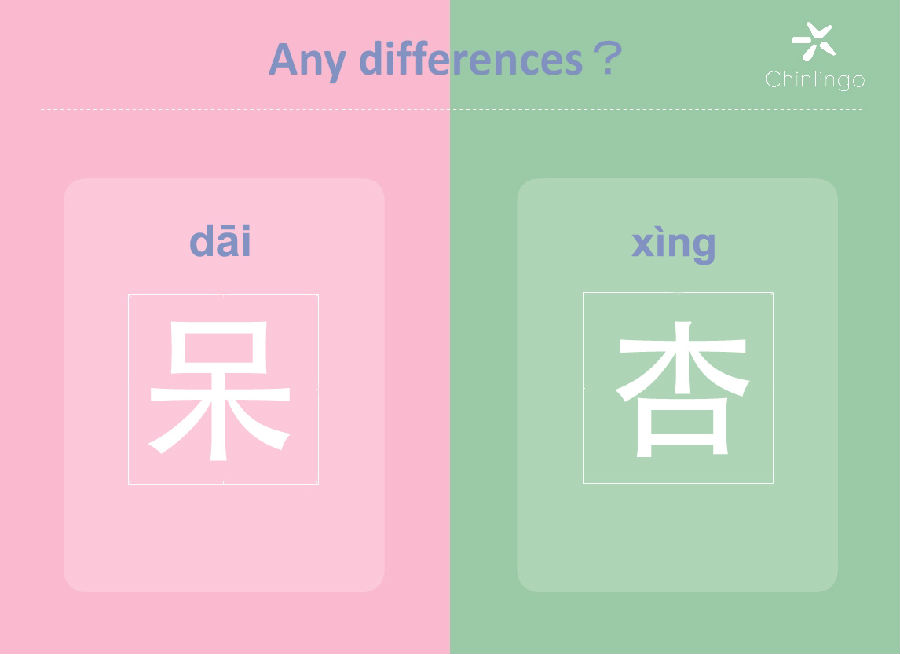
Different characters with same components
一样的偏旁部首,不一样的汉字
When I learn characters, I rely heavily on my understanding of how Chinese characters work (particularly when it comes to phonetic components), but I also make frequent use of mnemonics. I don't use them all the time, but I do employ them whenever I forget something I think I really ought to remember or when something refuses to stick.
我学习汉字时,很大程度上依赖于我对汉字结构的理解,尤其是在遇到声旁类汉字时。不过,我也常常会用到助记符。我倒不是总用这个方法,但针对那些我认为确实应该记住却忘了的东西或是记不牢的东西,我就会用助记符。
I use very simple mnemonics to remember characters, often just a single picture (scene) with the elements I need to incorporate. This usually just includes the character components, but sometimes tones as well.
我用非常简单的助记符来记忆汉字,通常只是一张涵盖我所需记忆元素的图片(场景)。其中往往只有汉字偏旁部首,有时也有标注声调。
Memorise components without placement
忽略布局,简单记忆偏旁部首
I memorise the components in whatever order makes the best mnemonic (usually what comes to mind first); I don't really need to remember that "grass" 艹 goes on top, that 扌 goes on the left and that 鳥 should be on the right, because that's almost always the case.
我以最能帮助记忆的顺序来记忆偏旁部首,通常是脑海里最先蹦出来的那个;我不需要记住 艹 要在"草"字的上面,扌在左边,而 鳥 应该在右边,因为通常都是这种情况。
The variety of component placement
偏旁部首布局的多样性
But sometimes the placement of the components makes all the difference. This is what I'm going to talk about in this article. Most of these characters are fairly rare, so don't make the mistake of just adding them to your spaced repetition program because you can. Another way of putting it is that unless you're an advanced learner, you will very rarely come across different characters that share the same components but in different configurations.
然而,有时偏旁部首布局不同,汉字完全不同。这就是我这篇文章将要讲到的内容。这些汉字大部分是非常少见的,所以,不要因为你会就错误地将它们添加到你的间隔重复计划中,除非你是个高阶学习者,不然你很难遇到偏旁部首相同而布局结构不同的不同汉字。
Different placement of the same components creates different characters
偏旁部首相同而布局不同组成不同的汉字
Here is a list of Chinese characters that have the same components but arranged differently. Note that these characters are not variants of each other, they are different characters, usually with completely different meanings and pronunciations!
以下是偏旁部首相同而布局结构不同的汉字。注意,这些汉字不是对应的变体,它们是不同的字,意思和发音通常也完全不同!
•蜒 yán (millipede) – 蜑 dàn(egg)
•怡 yí (joyful, happy) – 怠 dài (idle, slack)
•愀 qiǎo (to change one’' countenance) – 愁 chóu (to be anxious, worry)
•杲 gǎo (brilliant, bright sun) – 杳 yǎo (distant, out of sight)
•摸 mō (caress, touch) – 摹 mó (copy, trace)
•呆 dāi (dull, stupid) – 杏 xìng (almond, apricot)
•忠 zhōng (loyal) – 忡 chōng (grieved)
•忘 wàng (forget, neglect) – 忙 máng (busy)
•召 zhào (convene, summon) – 叨 dāo (talkative)
•含 hán (contain) – 吟 yín (chant, recite)
•唯 wéi (only) – 售 shòu (sell)
•啼 tí (weep, caw) – 啻 chì (merely)
•帛 bó (silk, fabrics) – 帕 pà (kerchief)
•某 mǒu (certain person or thing) – 柑 gān (tangerine)
•桉 ān (eucalyptus) – 案 àn (case, table)
•皇 huáng (emperor) – 珀 pò (amber)
•眇 miǎo (minute, blind) – 省 shěng/xǐng (save, province; be aware)
•音 yīn (sound) – 昱 yù (bright)
•机 jī (crucial point, engine) – 朵 duǒ (mw. for flowers)
•*垦 kěn (cultivate) – 垠 yín (limit)
•*吴 wú (a surname) – 吞 (swallow)
•*庄 zhuāng (village) – 圹 kuàng (tomb)
•翋 là (flying) – 翊 yì (assist, help, flying) – 翌 yì (daybreak, the next day)
•另 lìng (another) – 加 jiā (add) – 叻 lè (used for sound transcription)
•旭 xù (brilliant, rising sun) – 旮 gā (corner, nook) – 旯 lá (corner, nook)
*These only have the same components in simplified Chinese. Some might not actually share the same component, but they look the same or extremely similar.
*这些字只在简体中文里有相同的偏旁部首。实际上有一些字的偏旁部首可能不一样,但是它们看起来一样或者非常相似。
This list started with my own observations over a few years and has then been expanded by helpful people in the comment section (thanks to Andy and Els)!
上表是基于我个人多年观察经验、并由评论区的热心网友加以丰富拓展的(感谢Andy 和Els)!
Reminders for language learners
给语言学习者的提醒
For language learning purposes, this only becomes a problem when you encounter two or more from each set, which is unlikely to happen unless you learn a large number of characters. While this list is not exhaustive, it's also unlikely to happen because the phenomenon itself is rare.
从语言学习的角度来说,当你遇到每组的两个或两个以上时,你才需要去解决这个问题,当然这种情况不大可能发生,除非你学习大量汉字。尽管这个列表不够详尽,但这种情况也不大可能会遇到的,因为这种现象本身就很罕见。
This means that my method of not encoding order at all in mnemonics works find so long as you also have a decent understanding of characters and know what component goes where. For the small majority of cases above where this doesn't work, you can simply make an exception and make sure you get the order right in each.
这意味着,只要你对汉字理解恰当,并且知道偏旁部首该放在哪儿,那么,我提到的记忆法就很管用。上述少数情况用这个方法不起作用时,你可以破例,确保你知道每个助记符的正确顺序。
Simply it!
简化!
In general, keep things simple. Don't use mnemonics to encode and remember information you don't need to have in there. If you're going to include components and their order, pronunciation, tone and perhaps even more things, you need something approaching a short story to remember it. That's not time well-spent. Keep it simple. Remember only the things you really have to!
总之,要把复杂的事情简单化。不要用助记符来编码、记忆你不需要的信息。如果你要记住偏旁部首及其顺序、发音、音调,甚至更多信息,你需要看一篇短文来记忆。这样就没有充分利用好时间。务必简单化!只记忆你真正需要记的东西!
The article is translated and editted by Chinlingo. Please indicate the source for any use, reproduction or transfer.
本文由Chinlingo编译后发布,如需转载,请标明来源。



 闽公网安备 35020302035673号
闽公网安备 35020302035673号
0 responses on "Chinese characters with the same components in different placement"